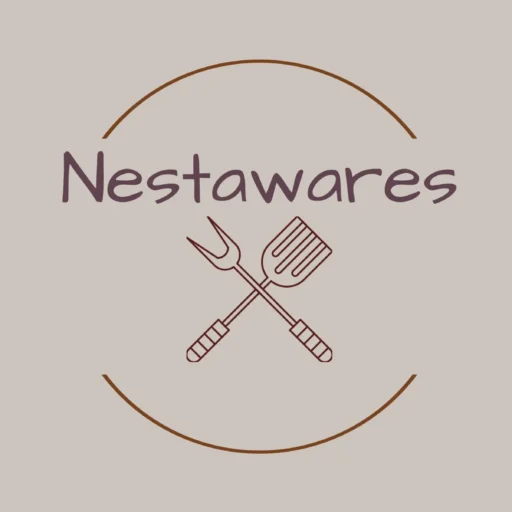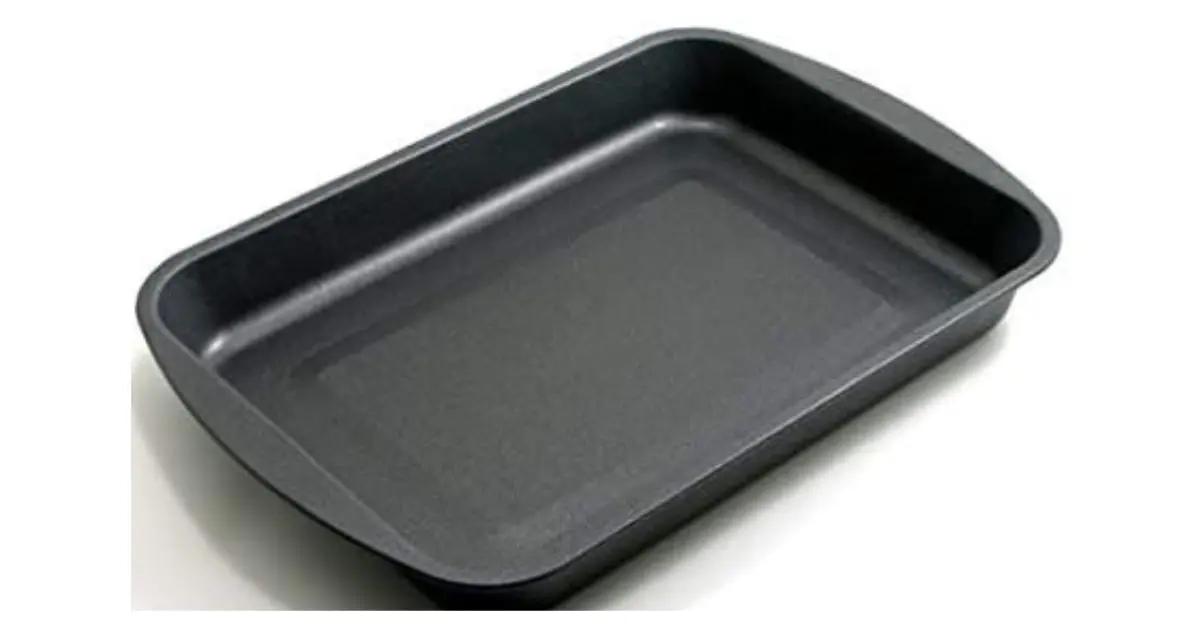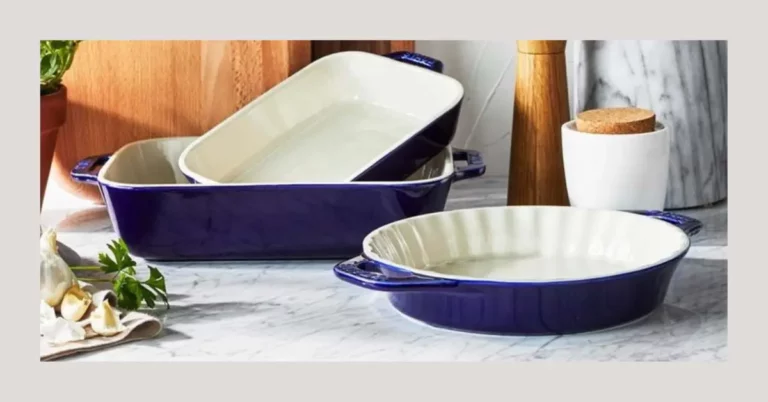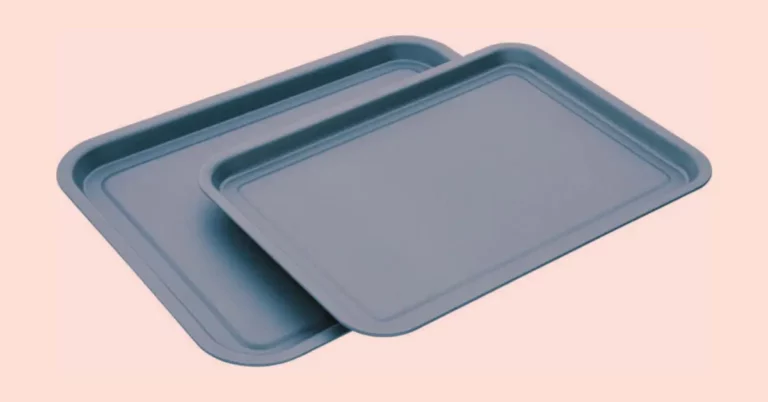Disclosure: As an Amazon associate, I may earn from qualifying purchases
Welcome back to the second part of our FAQ article on baking pans and the how Teflon still plays a big role in their construction. In our previous article, we explored the wonders of Teflon coating, its history, usage, and healthier alternatives.
Now, get ready to dive deeper as we continue our quest to answer more burning questions surrounding professional baking pans. From finding suitable replacements for Teflon to comparing different materials and addressing health concerns, this article has you covered.
While Teflon baking pans have long been favored for their non-stick properties, it’s natural to wonder about the alternatives available in the realm of professional baking. We’ll delve into a range of options, from silicone and glass to anodized aluminum and carbon steel, providing you with insights into their benefits and suitability for various baking tasks.
You can find out more on professional-grade bakeware and get the perfect replacement for your Teflon pans, ensuring exceptional results in the kitchen.
Comparing Teflon pans with bakeware made from other different materials is an essential aspect of making informed choices for your culinary adventures. We’ll discuss the advantages and disadvantages of each material, examining their heat conductivity, durability, and overall performance.
Whether you’re seeking precise temperature control, superior browning, or exceptional durability, our insights will help you navigate the vast landscape of professional baking pans.
Health and safety are paramount when it comes to choosing bakeware, and we understand the concerns surrounding Teflon coating. We’ll address the potential health issues associated with Teflon pans, providing you with balanced information to make he right choices when it comes to kitchenware.
Furthermore, we’ll explore the safety features offered by alternative materials, ensuring that your baking endeavors prioritize your well-being and peace of mind.
The benefits of professional baking pans extend beyond material considerations. The advantages of investing in high-quality bakeware includes superior heat distribution, enhanced durability, and exquisite presentation.
From achieving impeccable results with delicate pastries to showcasing culinary masterpieces with confidence, professional-grade baking pans are the key to taking your creations to new heights.
We’ve covered it all – from suitable replacements for Teflon pans to material comparisons, health considerations, and the remarkable benefits of professional-grade bakeware. Get ready to embrace a world of precision, performance, and delectable creations as we answer some of the most pressing questions on Teflon baking pans.
Now, get ready to dive deeper as we continue our quest to answer more burning questions surrounding professional baking pans. From finding suitable replacements for Teflon to comparing different materials and addressing health concerns, this article has you covered.
While Teflon baking pans have long been favored for their non-stick properties, it’s natural to wonder about the alternatives available in the realm of professional baking. We’ll delve into a range of options, from silicone and glass to anodized aluminum and carbon steel, providing you with insights into their benefits and suitability for various baking tasks.
You can find out more on professional-grade bakeware and get the perfect replacement for your Teflon pans, ensuring exceptional results in the kitchen.
Comparing Teflon pans with bakeware made from other different materials is an essential aspect of making informed choices for your culinary adventures. We’ll discuss the advantages and disadvantages of each material, examining their heat conductivity, durability, and overall performance.
Whether you’re seeking precise temperature control, superior browning, or exceptional durability, our insights will help you navigate the vast landscape of professional baking pans.
Health and safety are paramount when it comes to choosing bakeware, and we understand the concerns surrounding Teflon coating. We’ll address the potential health issues associated with Teflon pans, providing you with balanced information to make he right choices when it comes to kitchenware.
Furthermore, we’ll explore the safety features offered by alternative materials, ensuring that your baking endeavors prioritize your well-being and peace of mind.
The benefits of professional baking pans extend beyond material considerations. The advantages of investing in high-quality bakeware includes superior heat distribution, enhanced durability, and exquisite presentation.
From achieving impeccable results with delicate pastries to showcasing culinary masterpieces with confidence, professional-grade baking pans are the key to taking your creations to new heights.
We’ve covered it all – from suitable replacements for Teflon pans to material comparisons, health considerations, and the remarkable benefits of professional-grade bakeware. Get ready to embrace a world of precision, performance, and delectable creations as we answer some of the most pressing questions on Teflon baking pans.
Frequently Asked Questions
What baking pans do professional bakers use?
Professional bakers typically use a variety of baking pans depending on the type of baked goods they are making. And some of those include:
Professional bakers may also use specialized pans for specific baked goods, such as brioche pans, madeleine pans, and tartlet pans.
- Aluminum sheet pans: These are multi-purpose and strong pans that are commonly used for baking cookies, sheet cakes, and pastries.
- Springform pans: These are round pans with a removable bottom that allows for easy removal of delicate cakes like cheesecakes and tortes.
- Loaf pans: These are rectangular pans that are used for baking bread, pound cakes, and meatloaf.
- Muffin pans: These pans have multiple cups and are used for baking muffins, cupcakes, and individual-sized quiches or frittatas.
- Pie pans: These pans are used for baking pies, quiches, and tarts.
- Cake pans: These are round or square pans that are used for baking layer cakes, coffee cakes, and other desserts.
Professional bakers may also use specialized pans for specific baked goods, such as brioche pans, madeleine pans, and tartlet pans.
Does parchment paper have Teflon?
No, parchment paper does not contain Teflon. It is a grease- and moisture-resistant paper that is coated with silicone, which makes it non-stick and heat-resistant.
The silicone coating is different from Teflon, which is a synthetic polymer containing a chemical called polytetrafluoroethylene (PTFE).
The silicone coating is different from Teflon, which is a synthetic polymer containing a chemical called polytetrafluoroethylene (PTFE).
What replaced Teflon in pans?
There are several materials that have replaced Teflon in pans, including:
- Ceramic coating is a popular alternative to Teflon. It is made of a natural material, and it is free from PFOA and PTFE. Ceramic coating is scratch-resistant and provides a non-stick surface for cooking.
- Stainless steel is a tough and safe material for cookware. It does not contain any harmful chemicals and does not leach into food. Their pans can also be used for a wide range of cooking techniques.
- Cast iron is another popular alternative too. It is made from natural materials and does not contain any harmful chemicals. They are also very strong and can last for many years.
- Anodized aluminum is a type of aluminum that has been treated with an electrochemical process. This makes it harder and more resilient than regular aluminum. Anodized aluminum pans are also non-stick and easy to clean.
- Carbon steel: Carbon steel is a popular choice for professional bakers. It is tough, heats evenly, and provides a non-stick surface for baking. Their pans are also relatively inexpensive and easy to find.
What pans do not use Teflon?
There are several types of pans that do not use Teflon, including:
Some non-stick coatings used in pans may still contain PTFE and PFOA, so it’s always best to check the manufacturer’s labeling or contact them directly to confirm.
- Stainless steel pans: These are a popular choice for many cooks and are durable, long-lasting, and can be used for a wide range of cooking methods.
- Cast iron pans: These are known for their even heating and ability to retain heat, making them great for searing and frying.
- Ceramic-coated pans: These are non-stick pans that are coated with a natural ceramic material that is free of PFOA and PTFE.
- Anodized aluminum pans: These are treated with an electrochemical process that hardens the surface of the aluminum, making them scratch-resistant and non-stick.
- Carbon steel pans: These are similar to cast iron pans but are lighter and have a smoother surface. They are great for searing and sautéing.
Some non-stick coatings used in pans may still contain PTFE and PFOA, so it’s always best to check the manufacturer’s labeling or contact them directly to confirm.
Are ceramic coated pans better than Teflon?
Ceramic-coated pans are considered to be a safer and more environmentally friendly alternative to Teflon-coated pans.
Ceramic coatings are made of natural materials and are generally free of PFOA, PFAS, and other potentially harmful chemicals.
They also tend to be more solidly built than Teflon coatings and can withstand higher temperatures, making them suitable for a wider range of cooking applications.
It is worth noting however, that ceramic-coated pans can be more expensive than Teflon-coated pans and may require more careful handling and cleaning to maintain their nonstick properties.
Ceramic coatings are made of natural materials and are generally free of PFOA, PFAS, and other potentially harmful chemicals.
They also tend to be more solidly built than Teflon coatings and can withstand higher temperatures, making them suitable for a wider range of cooking applications.
It is worth noting however, that ceramic-coated pans can be more expensive than Teflon-coated pans and may require more careful handling and cleaning to maintain their nonstick properties.
What does Gordon Ramsay use for pans?
Gordon Ramsay is known to use a variety of cookware brands in his kitchens, depending on his needs for a specific dish.
He has endorsed brands such as All-Clad, Le Creuset, and Scanpan in the past, and he also has his own line of cookware called the Gordon Ramsay Maze Collection.
He has endorsed brands such as All-Clad, Le Creuset, and Scanpan in the past, and he also has his own line of cookware called the Gordon Ramsay Maze Collection.
Is Teflon still unhealthy?
Teflon itself is not considered unhealthy when used properly, but there are potential health concerns associated with the use of such pans.
When Teflon is heated to very high temperatures (above 570°F or 300°C), it can release toxic fumes that can cause flu-like symptoms in humans and can be lethal to birds.
This is known as the “Teflon flu” or “polymer fume fever.”
However, the risk of experiencing these symptoms from normal cooking with Teflon pans is low, as most cooking occurs at temperatures below the point where the coating begins to break down.
Thus, PTFE pans should be used properly and we must remember not to overheat them, which can release toxic fumes.
There are also concerns about the environmental impact of this coating, as it is a non-biodegradable material and can potentially accumulate in the environment and in living organisms.
When Teflon is heated to very high temperatures (above 570°F or 300°C), it can release toxic fumes that can cause flu-like symptoms in humans and can be lethal to birds.
This is known as the “Teflon flu” or “polymer fume fever.”
However, the risk of experiencing these symptoms from normal cooking with Teflon pans is low, as most cooking occurs at temperatures below the point where the coating begins to break down.
Thus, PTFE pans should be used properly and we must remember not to overheat them, which can release toxic fumes.
There are also concerns about the environmental impact of this coating, as it is a non-biodegradable material and can potentially accumulate in the environment and in living organisms.
When was Teflon stopped being used?
Teflon is still in use in some cookware and other products, but its use has decreased over time due to concerns over its potential health effects.
In 2006, the Environmental Protection Agency (EPA) reached a settlement with DuPont, the primary manufacturer of Teflon, over allegations that the company had failed to report information regarding the health and environmental risks associated with the chemical.
Since then, many manufacturers have begun producing non-stick cookware that does not use PFOA, the chemical used in the production of Teflon. However, Teflon-coated cookware is still available and in use.
In 2006, the Environmental Protection Agency (EPA) reached a settlement with DuPont, the primary manufacturer of Teflon, over allegations that the company had failed to report information regarding the health and environmental risks associated with the chemical.
Since then, many manufacturers have begun producing non-stick cookware that does not use PFOA, the chemical used in the production of Teflon. However, Teflon-coated cookware is still available and in use.
Did anyone go to jail over Teflon?
Yes, in 2005, DuPont executive Michael P. Wright pleaded guilty to charges of violating federal environmental laws by withholding information about the health and environmental risks associated with PFOA, a key ingredient in Teflon.
Wright was sentenced to community service and probation.
Wright was sentenced to community service and probation.
How many countries have banned Teflon cookware?
Some countries have placed restrictions on the use of PFOA, a chemical used in the production of Teflon.
For instance, the European Union has banned the use of PFOA in the production of all consumer products, including cookware.
For instance, the European Union has banned the use of PFOA in the production of all consumer products, including cookware.
Are scratched Teflon pans safe?
No, scratched Teflon pans are not safe to use. When these pans are scratched or damaged, the non-stick coating can flake off and mix with the food.
If the flakes are ingested, they can be harmful to human health. The exposed metal underneath the coating can react with acidic or alkaline foods and cause them to taste metallic or affect the food’s color.
Therefore, it is recommended to replace scratched pans coated with PTFE/PFOA.
If the flakes are ingested, they can be harmful to human health. The exposed metal underneath the coating can react with acidic or alkaline foods and cause them to taste metallic or affect the food’s color.
Therefore, it is recommended to replace scratched pans coated with PTFE/PFOA.
At what temperature does Teflon release chemicals?
Teflon starts to release toxic fumes at temperatures above 500°F (260°C). At this temperature, the coating begins to break down, and the fumes can cause polymer fume fever, a temporary flu-like illness.




